The Stabilization Mechanism of a Stable Landslide Dam on the Eastern Margin of the Tibetan Plateau, China: Insights from Field Investigation and Numerical Simulation
Abstract
1. Introduction
2. Regional Geological Background
3. Methodology
3.1. Field Investigation and Laboratory Sieving
3.2. Numerical Simulation
4. Results
4.1. Characteristics of the Conaxue Co Landslide Dam
4.2. Particle Transport Results of 3D Dam Model
4.3. The Seepage Results of 2D Dam Model
5. Discussion
5.1. Stability Mechanism
5.2. Stability Patterns
5.3. Limitations and Perspectives
6. Conclusions
Author Contributions
Funding
Institutional Review Board Statement
Informed Consent Statement
Data Availability Statement
Conflicts of Interest
References
- Casagli, N.; Ermini, L. Geomorphic analysis of landslide dams in the Northern Apennine. Trans.—Jpn. Geomorphol. Union 1999, 20, 219–249. [Google Scholar]
- Costa, J.E. and Schuster, R.L. The formation and failure of natural dams. Geol. Soc. Am. Bull. 1988, 100, 1054–1068. [Google Scholar] [CrossRef]
- Chen, J.; Li, H. Genetic mechanism and disasters features of complicated structural rock mass along the rapidly uplift section at the upstream of Jinsha River. J. Jilin Univ. (Earth. Sci. Ed.) 2016, 46, 1153–1167. [Google Scholar]
- Li, Y.; Wang, C.; Dai, J.; Xu, G.; Hou, Y.; Li, X. Propagation of the deformation and growth of the Tibetan–Himalayan orogen: A review. Earth-Sci. Rev. 2015, 143, 36–61. [Google Scholar] [CrossRef]
- Zhan, J.; Chen, J.; Zhang, W.; Han, X.; Sun, X.; Bao, Y. Mass movements along a rapidly uplifting river valley: An example from the upper Jinsha River, southeast margin of the Tibetan Plateau. Environ. Earth Sci. 2018, 77, 634. [Google Scholar] [CrossRef]
- Li, J.; Fang, X.; Pan, B.; Zhao, Z.; Song, Y. Late Cenozoic Intensive Uplift of the Tibetan Plateau and Its Impacts on the Surrounding Environments. Quat. Res. 2001, 21, 381–391. [Google Scholar]
- Zhu, S. Geomorphological and Geological Environmental Evolution of the Yarlung Tsangpo River Valley; Chinese Academy of Geological Sciences: Beijing, China, 2012. [Google Scholar]
- Dai, F.; Lee, C.F.; Deng, J.; Tham, L. The 1786 earthquake-triggered landslide dam and subsequent dam-break flood on the Dadu River, southwestern China. Geomorphology 2005, 65, 205–221. [Google Scholar] [CrossRef]
- Zhao, B.; Wang, Y.; Wu, J.; Su, L.; Liu, J.; Jin, G. The Mogangling giant landslide triggered by the 1786 Moxi M 7.75 earthquake, China. Nat. Hazards 2021, 106, 459–485. [Google Scholar] [CrossRef]
- Guo, C.; Montgomery, D.R.; Zhang, Y.; Zhong, N.; Fan, C.; Wu, R.; Yang, Z.; Ding, Y.; Jin, J.; Yan, Y. Evidence for repeated failure of the giant Yigong landslide on the edge of the Tibetan Plateau. Sci. Rep. 2020, 10, 14371. [Google Scholar] [CrossRef]
- Shang, Y.; Park, H.-D.; Yang, Z.; Yang, J. Distribution of landslides adjacent to the northern side of the Yarlu Tsangpo Grand Canyon in Tibet, China. Environ. Geol. 2005, 48, 721–741. [Google Scholar] [CrossRef]
- Liu, D.; Cui, Y.; Wang, H.; Jin, W.; Wu, C.; Bazai, N.A.; Zhang, G.; Carling, P.A.; Chen, H. Assessment of local outburst flood risk from successive landslides: Case study of Baige landslide-dammed lake, upper Jinsha river, eastern Tibet. J. Hydrol. 2021, 599, 126294. [Google Scholar] [CrossRef]
- Zhang, L.; Xiao, T.; He, J.; Chen, C. Successive landsliding and damming of the Jinsha River in eastern Tibet, China: Prime investigation, early warning, and emergency response. Landslides 2019, 16, 583–596. [Google Scholar] [CrossRef]
- Zhong, Q.; Chen, S.; Wang, L.; Shan, Y. Back analysis of breaching process of Baige landslide dam. Landslides 2020, 17, 1681–1692. [Google Scholar] [CrossRef]
- Zhang, L.; Xiao, T.; He, J.; Chen, C. Erosion-based analysis of breaching of Baige landslide dams on the Jinsha River, China, in 2018. Landslides 2019, 16, 1965–1979. [Google Scholar] [CrossRef]
- Song, L.; Wang, Y.-S.; Hu, D.-Y.; Wu, H.-C.; Tang, T.; Liu, S.-C. Insights into the long-term stability of landslide dams on the eastern margin of the Tibetan Plateau, China–A case study of the Diexi area. J. Mt. Sci. 2023, 20, 1674–1694. [Google Scholar] [CrossRef]
- Song, L.; Wang, Y.; Zhao, Y.; Xiao, Z.; Feng, Z.; Liu, S.; Tang, T. Distribution and Stabilization Mechanisms of Stable Landslide Dams. Sustainability 2024, 16, 3646. [Google Scholar] [CrossRef]
- Tapponnier, P.; Xu, Z.Q.; Roger, F.; Meyer, B.; Arnaud, N.; Wittlinger, G.; Yang, J.S. Oblique stepwise rise and growth of the Tibet Plateau. Science 2001, 294, 1671–1677. [Google Scholar] [CrossRef]
- Chen, G.; Xu, X.; Wen, X.; Wang, Y. Coseismic slip distribution of the 2010 Yushu earthquake derived from joint inversion of InSAR and GPS data. Seismol. Res. Lett. 2010, 81, 703–711. [Google Scholar]
- Casagli, N.; Ermini, L.; Rosati, G. Determining grain size distribution of the material composing landslide dams in the Northern Apennines: Sampling and processing methods. Eng. Geol. 2003, 69, 83–97. [Google Scholar] [CrossRef]
- Troncone, A.; Pugliese, L.; Parise, A.; Mazzuca, P.; Conte, E. Post-failure stage analysis of flow-type landslides using different numerical techniques. Comput. Geotech. 2025, 182, 107152. [Google Scholar] [CrossRef]
- Pastor, M.; Tayyebi, S.M.; Stickle, M.M.; Yagüe, Á.; Molinos, M.; Navas, P.; Manzanal, D. A depth integrated, coupled, two-phase model for debris flow propagation. Acta Geotech. 2021, 16, 2409–2433. [Google Scholar] [CrossRef]
- Bao, Y.; Su, L.; Chen, J.; Zhang, C.; Zhao, B.; Zhang, W.; Zhang, J.; Hu, B.; Zhang, X. Numerical investigation of debris flow–structure interactions in the Yarlung Zangbo River valley, north Himalaya, with a novel integrated approach considering structural damage. Acta Geotech. 2023, 18, 5859–5881. [Google Scholar] [CrossRef]
- Li, W.; Qian, J.; Yin, Z.; Zhou, C. CFD-DEM Coupled Simulation of Seepage Erosion in Gap-Graded Sandy Soils. Rock. Soil. Mech. 2021, 42, 123–135. [Google Scholar]
- Wang, Z.; Ruiken, A.; Jacobs, F.; Ziegler, M. A new suggestion for determining 2D porosities in DEM studies. Geomech. Eng. 2014, 7, 665–678. [Google Scholar] [CrossRef]
- Wang, F.; Cheng, Q.; Highland, L.; Miyajima, M.; Wang, H.; Yan, C. Preliminary investigation of some large landslides triggered by the 2008 Wenchuan earthquake, Sichuan Province, China. Landslides 2009, 6, 47–54. [Google Scholar]
- Gorum, T.; Fan, X.; van Westen, C.J.; Huang, R.Q.; Xu, Q.; Tang, C.; Wang, G. Distribution pattern of earthquake-induced landslides triggered by the 2008 Wenchuan earthquake. Geomorphology 2011, 133, 152–167. [Google Scholar] [CrossRef]
- Wang, Y. Experimental Study on Air-Entrainment Fluidization Mechanisms of High-Speed Long-Runout Landslides; Southwest Jiaotong University Press: Chengdu, China, 2014. [Google Scholar]
- Wang, Y.; Cheng, Q.; Zhu, Q. Inverse Grading Characteristics and Mechanisms of Debris Flow Deposits Triggered by the Wenchuan Earthquake. Chin. J. Rock Mech. Eng. 2012, 31, 1089–1106. [Google Scholar]
- Zheng, G.; Xu, Q.; Peng, S. Depositional Characteristics and Mechanisms of Landslide-Generated Debris Flows. J. Eng. Geol. 2019, 27, 785–795. [Google Scholar]
- Cheng, Q. Dynamics of High-Speed Rock Landslides; Southwest Jiaotong University Press: Chengdu, China, 1999. [Google Scholar]
- Ren, S. Development Characteristics and Formation Mechanisms of Landslide Damming in the Alpine Gorge Region of the Upper Min River. Master’s Thesis, China University of Geosciences (Beijing), Beijing, China, 2018. [Google Scholar]
- Xu, J.; Wang, Z. Formation Mechanisms and Functional Roles of Step-Pool Systems. J. Hydraul. Eng. 2004, 1–9. [Google Scholar]
- Wang, Z.Y.; Melching, C.S.; Duan, X.H.; Yu, G.A. Ecological and Hydraulic Studies of Step-Pool Systems. J. Hydraul. Eng. 2009, 135, 705–717. [Google Scholar] [CrossRef]
- Wang, Z.; Cui, P.; Yu, G.; Zhang, K. Stability of landslide dams and development of knickpoints. Environ. Earth Sci. 2012, 64, 1067–1080. [Google Scholar] [CrossRef]
- Lenzi, M.A. Stream bed stabilization using boulder check dams that mimic step-pool morphology features in Northern Italy. Geomorphology 2002, 45, 243–260. [Google Scholar] [CrossRef]
- Wang, Z.; Zhang, C. Riverbed Structures and Energy Dissipation-Hazard Mitigation Mechanisms in Southwestern Mountainous Rivers. J. Hydraul. Eng. 2019, 50, 124–134+154. [Google Scholar]
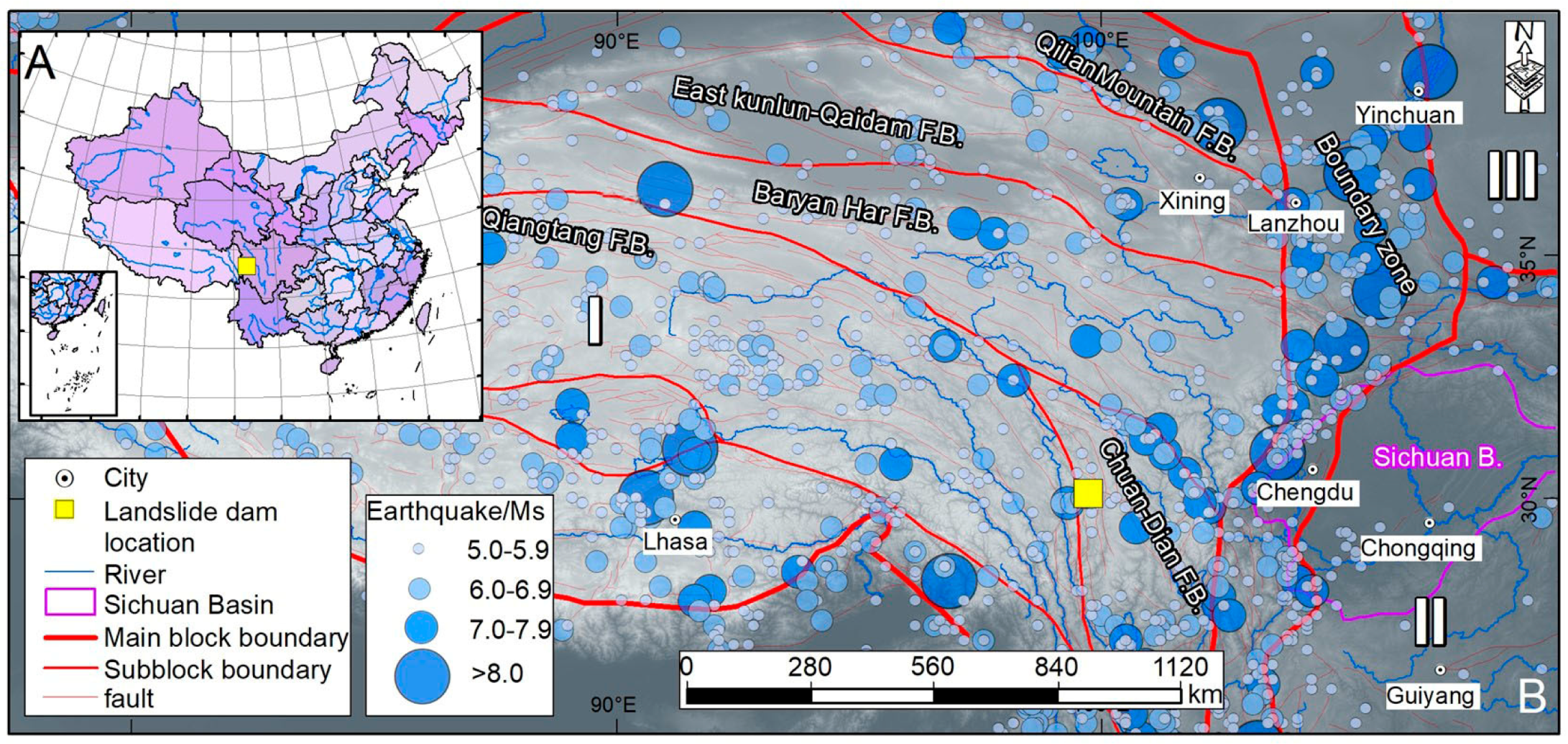

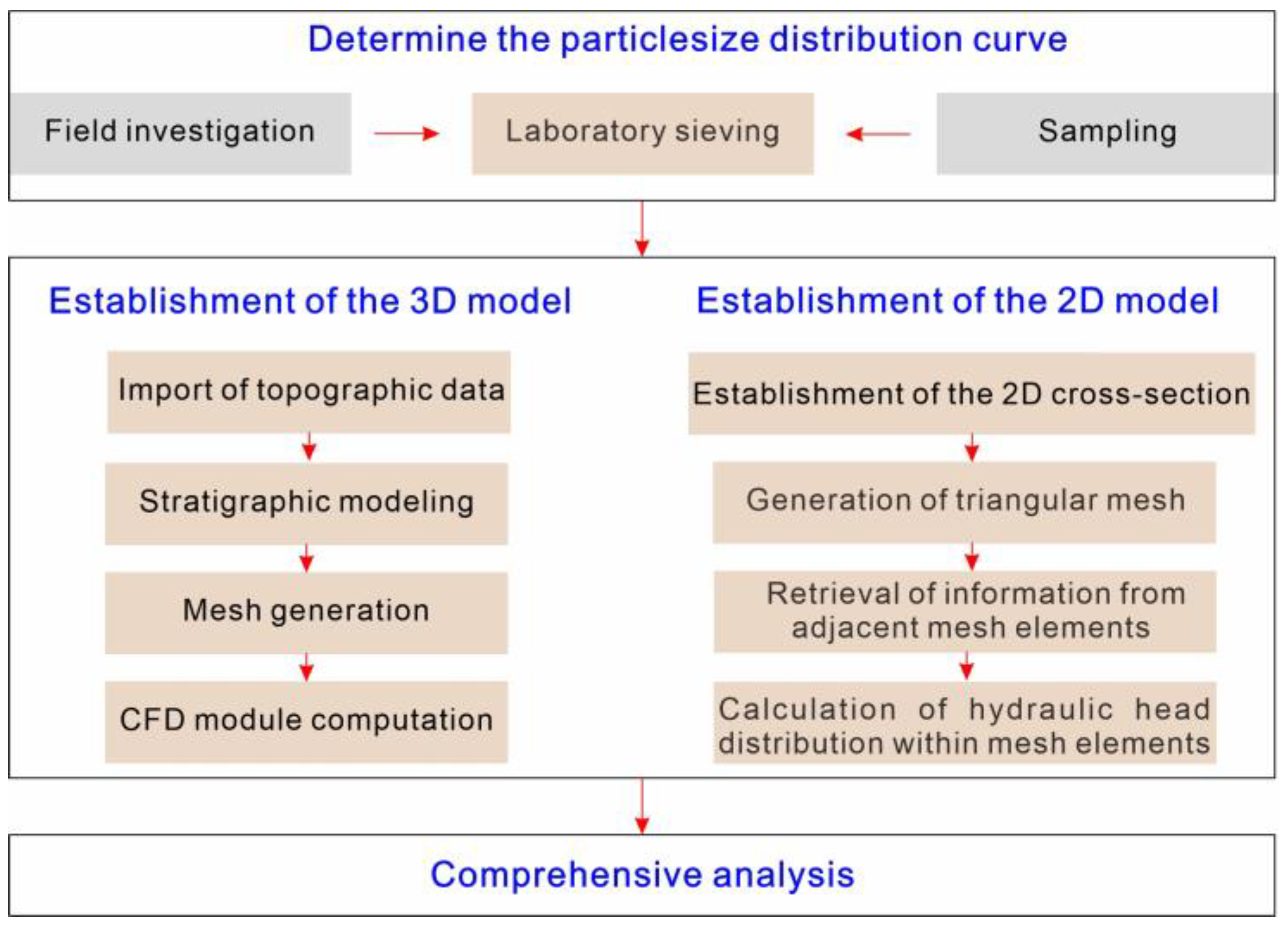
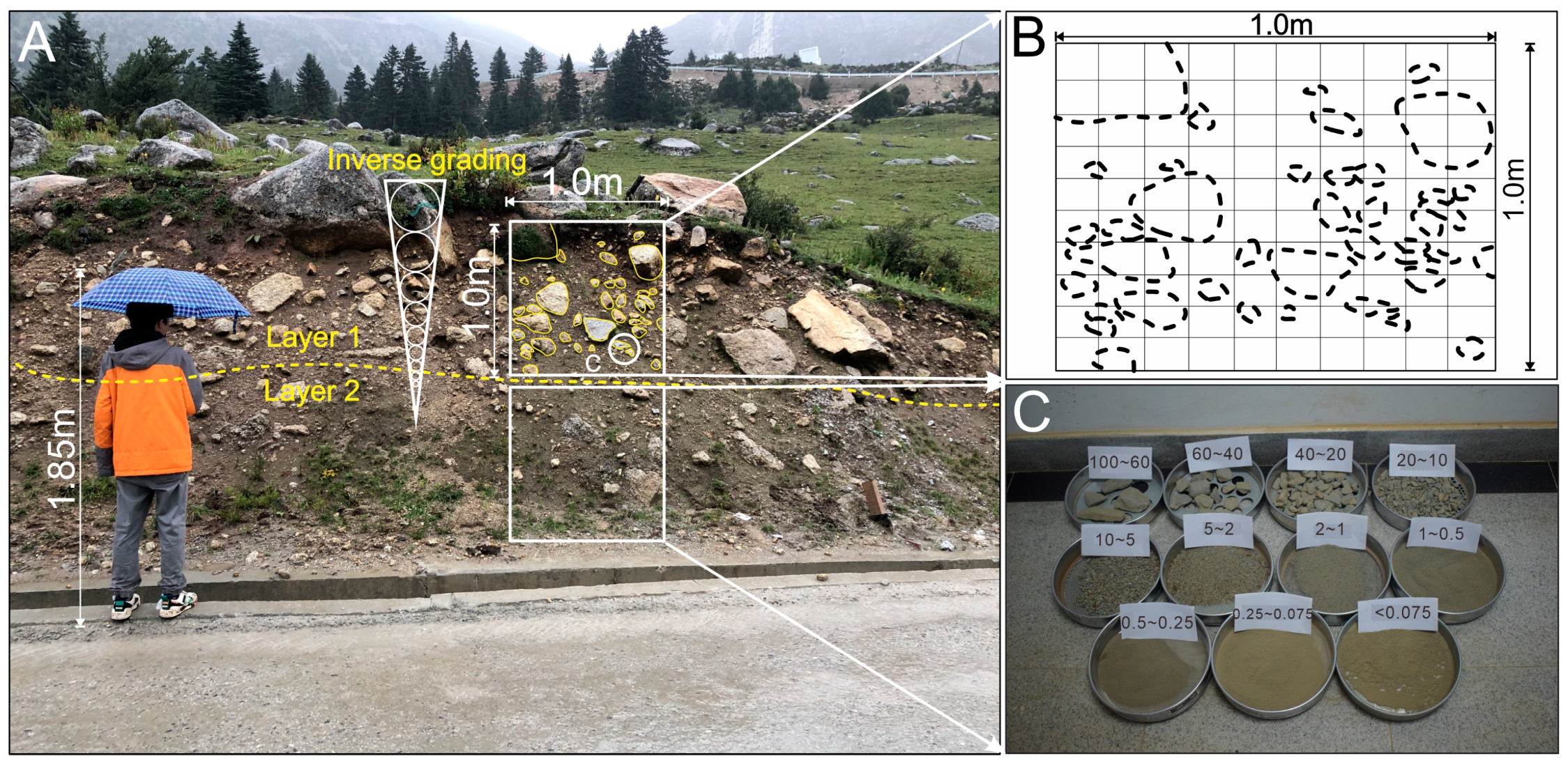


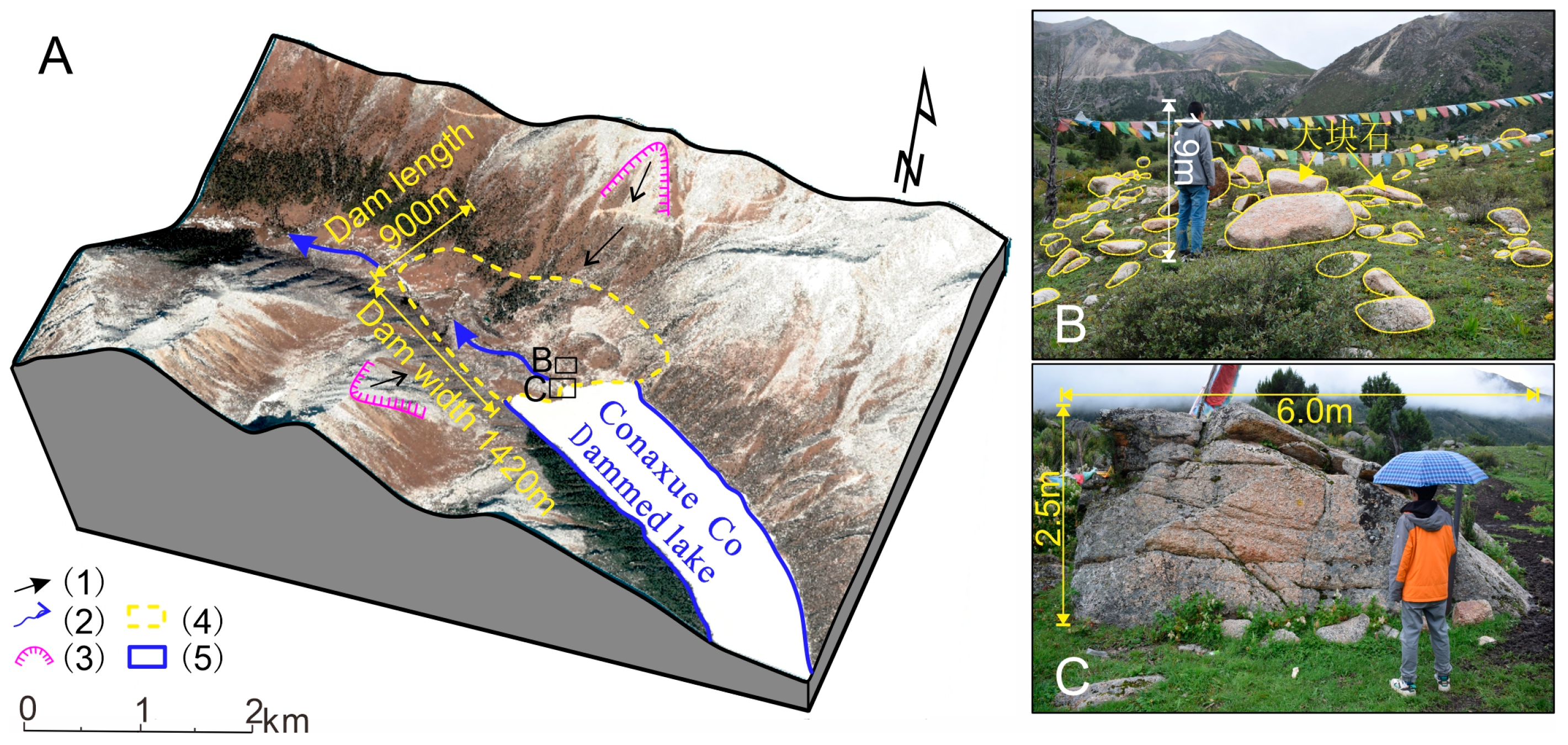

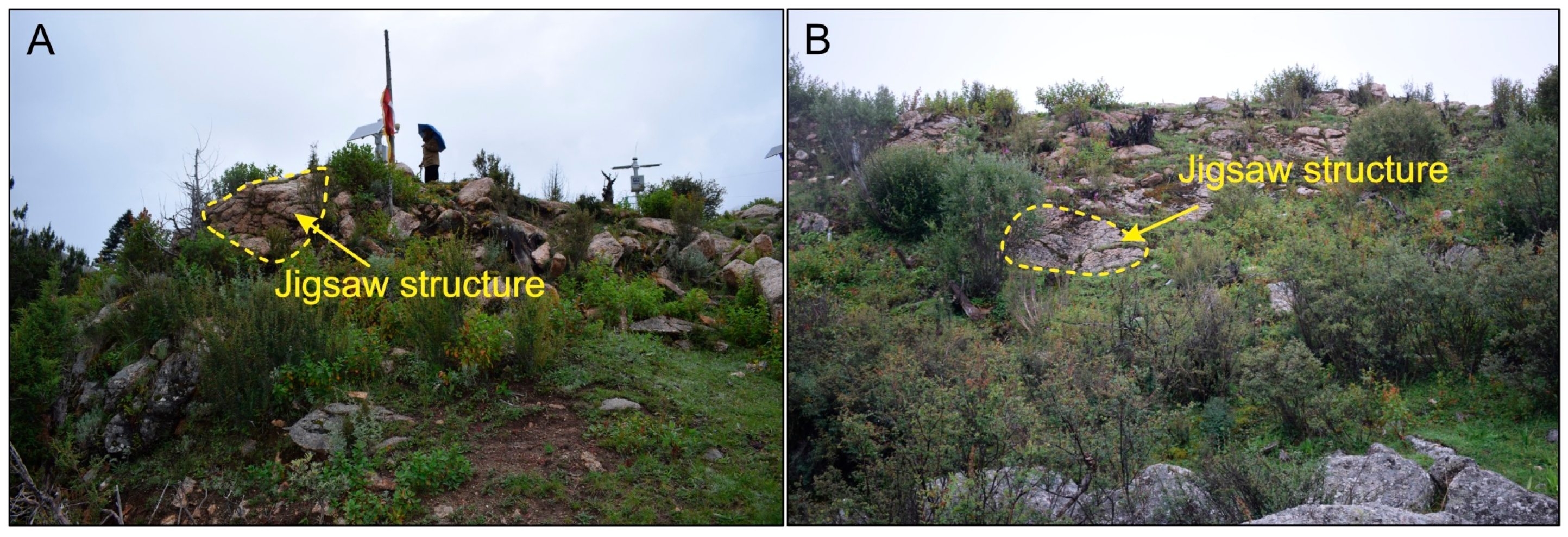


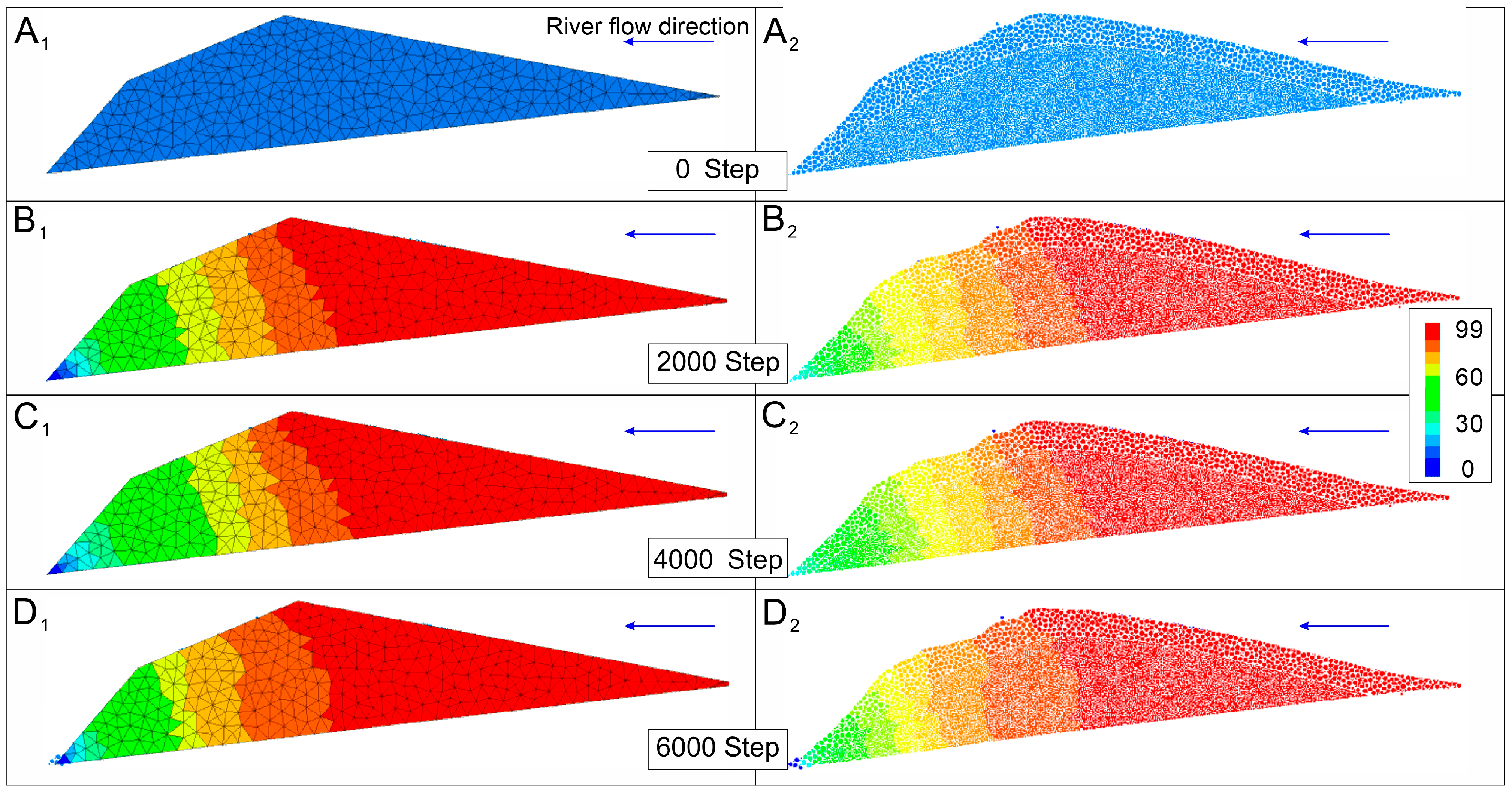








| Dam Structure | Elastic Modulus E (MPa) | Poisson’s Ratio | Friction Coefficient | Coefficient of Restitution | Particle Density ρ (kg·m−3) | Anti-Rotation Coefficient μr |
|---|---|---|---|---|---|---|
| Layer 1 | 200 | 0.5 | 0.5 | 0.3 | 2650 | 0.1 |
| Layer 2 | 100 | 0.3 | 0.4 | 0.3 | 2350 | 0.1 |
Disclaimer/Publisher’s Note: The statements, opinions and data contained in all publications are solely those of the individual author(s) and contributor(s) and not of MDPI and/or the editor(s). MDPI and/or the editor(s) disclaim responsibility for any injury to people or property resulting from any ideas, methods, instructions or products referred to in the content. |
© 2025 by the authors. Licensee MDPI, Basel, Switzerland. This article is an open access article distributed under the terms and conditions of the Creative Commons Attribution (CC BY) license (https://creativecommons.org/licenses/by/4.0/).
Share and Cite
Song, L.; Shang, Y.; Wang, Y.; Li, T.; Xiao, Z.; Zhao, Y.; Tang, T.; Liu, S. The Stabilization Mechanism of a Stable Landslide Dam on the Eastern Margin of the Tibetan Plateau, China: Insights from Field Investigation and Numerical Simulation. Appl. Sci. 2025, 15, 8745. https://doi.org/10.3390/app15158745
Song L, Shang Y, Wang Y, Li T, Xiao Z, Zhao Y, Tang T, Liu S. The Stabilization Mechanism of a Stable Landslide Dam on the Eastern Margin of the Tibetan Plateau, China: Insights from Field Investigation and Numerical Simulation. Applied Sciences. 2025; 15(15):8745. https://doi.org/10.3390/app15158745
Chicago/Turabian StyleSong, Liang, Yanjun Shang, Yunsheng Wang, Tong Li, Zhuolin Xiao, Yuchao Zhao, Tao Tang, and Shicheng Liu. 2025. "The Stabilization Mechanism of a Stable Landslide Dam on the Eastern Margin of the Tibetan Plateau, China: Insights from Field Investigation and Numerical Simulation" Applied Sciences 15, no. 15: 8745. https://doi.org/10.3390/app15158745
APA StyleSong, L., Shang, Y., Wang, Y., Li, T., Xiao, Z., Zhao, Y., Tang, T., & Liu, S. (2025). The Stabilization Mechanism of a Stable Landslide Dam on the Eastern Margin of the Tibetan Plateau, China: Insights from Field Investigation and Numerical Simulation. Applied Sciences, 15(15), 8745. https://doi.org/10.3390/app15158745








